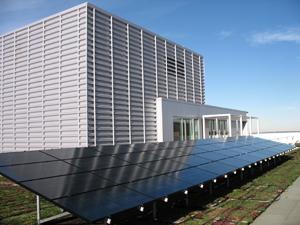Renewable Energy
Using renewable energy reduces greenhouse gas (GHG) emissions and air pollution associated with energy production and helps diversify the nation’s energy supply. EPA supports the growing green power market by purchasing and generating renewable energy in a variety of forms.

Solar panels at EPA’s Region 8 Office in Denver, Colorado
“Green power” is a subset of renewable energy and represents those renewable energy resources and technologies that provide the highest environmental benefit by reducing the emissions associated with traditional electricity sources. Sources of renewable energy include:
- Wind power
- Solar power
- Geothermal technologies
- Landfill gas
- Biomass power
- Low-impact small hydropower
EPA acquires green power in one of three ways:
- Onsite generation
- Utility-supplied green power
- Renewable energy certificates (RECs)
These purchases promote growth in the green power marketplace and help the Agency avoid greenhouse gas emissions associated with its energy consumption. In fact, EPA was the first major federal agency to purchase renewable energy equal to 100 percent of its estimated annual electricity use nationwide.
In this section:
